| Solar eclipse of June 1, 2030 | |
|---|---|
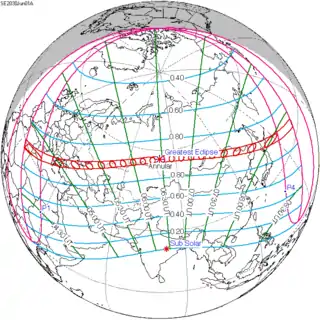 Map | |
| Type of eclipse | |
| Nature | Annular |
| Gamma | 0.5626 |
| Magnitude | 0.9443 |
| Maximum eclipse | |
| Duration | 321 sec (5 m 21 s) |
| Coordinates | 56°30′N 80°06′E / 56.5°N 80.1°E |
| Max. width of band | 250 km (160 mi) |
| Times (UTC) | |
| Greatest eclipse | 6:29:13 |
| References | |
| Saros | 128 (59 of 73) |
| Catalog # (SE5000) | 9575 |
An annular solar eclipse will occur on Saturday, June 1, 2030. A solar eclipse occurs when the Moon passes between Earth and the Sun, thereby totally or partly obscuring the image of the Sun for a viewer on Earth. An annular solar eclipse occurs when the Moon's apparent diameter is smaller than the Sun's, blocking most of the Sun's light and causing the Sun to look like an annulus (ring). An annular eclipse appears as a partial eclipse over a region of the Earth thousands of kilometres wide.
An annular eclipse will start on the north of Africa and will cross Eurasian continent, will cross Algeria, Tunisia, Libya, Malta, Greece, Turkey, Bulgaria, Ukraine, Russia, Kazakhstan, China and Japan. An eclipse will pass through lot of large cities such as Tripoli, Athens, Istanbul, Krasnodar, Rostov-on-Don, Volgograd, Omsk, Krasnoyarsk and Sapporo.
Images
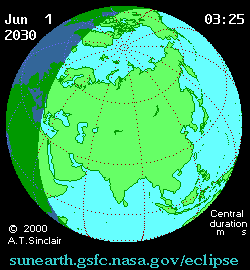
Animated path
Related eclipses
Solar eclipses 2029–2032
This eclipse is a member of a semester series. An eclipse in a semester series of solar eclipses repeats approximately every 177 days and 4 hours (a semester) at alternating nodes of the Moon's orbit.[1]
Note: Partial solar eclipses on January 14, 2029 and July 11, 2029 occur on the previous lunar year eclipse set.
| Solar eclipse series sets from 2029–2032 | ||||
|---|---|---|---|---|
| Descending node | Ascending node | |||
| 118 | June 12, 2029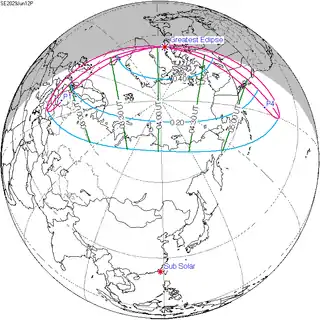 Partial |
123 | December 5, 2029 Partial | |
| 128 | June 1, 2030 Annular |
133 | November 25, 2030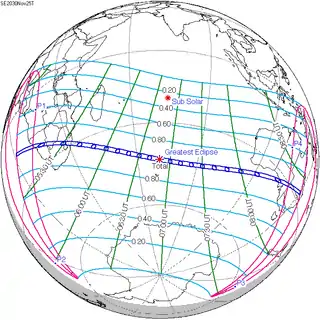 Total | |
| 138 | May 21, 2031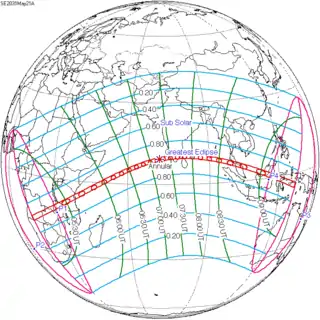 Annular |
143 | November 14, 2031 Hybrid | |
| 148 | May 9, 2032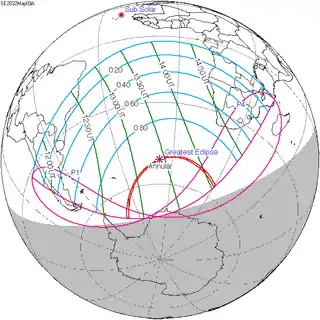 Annular |
153 | November 3, 2032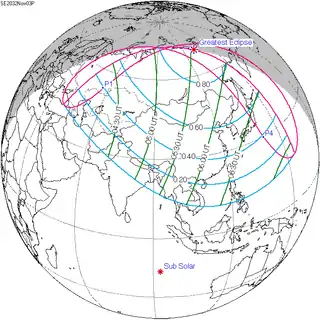 Partial | |
Saros 128
This eclipse is a member of the Solar Saros cycle 128, which includes 73 eclipses occurring in intervals of 18 years and 11 days. The series started with partial solar eclipse on August 29, 984 AD. From May 16, 1417 through June 18, 1471 the series produced total solar eclipses, followed by hybrid solar eclipses from June 28, 1489 through July 31, 1543, and annular solar eclipses from August 11, 1561 through July 25, 2120. The series ends at member 73 as a partial eclipse on November 1, 2282. All eclipses in this series occurs at the Moon’s descending node.
| Series members 52–68 occur between 1901 and 2200 | ||
|---|---|---|
| 52 | 53 | 54 |
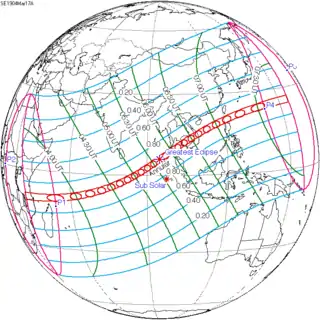 March 17, 1904 |
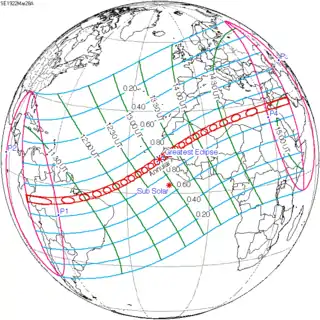 March 28, 1922 |
 April 7, 1940 |
| 55 | 56 | 57 |
 April 19, 1958 |
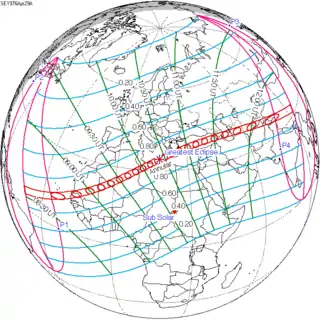 April 29, 1976 |
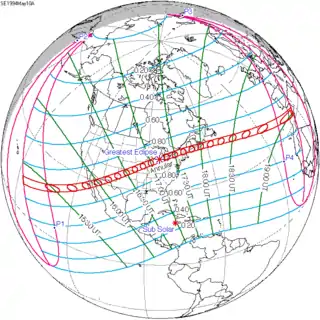 May 10, 1994 |
| 58 | 59 | 60 |
 May 20, 2012 |
 June 1, 2030 |
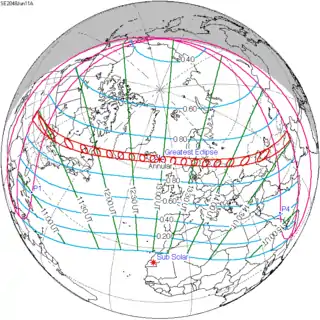 June 11, 2048 |
| 61 | 62 | 63 |
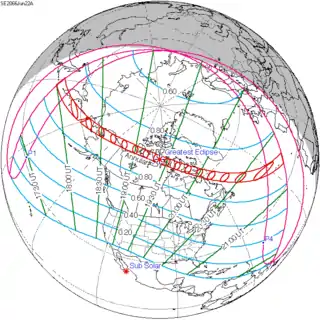 June 22, 2066 |
 July 3, 2084 |
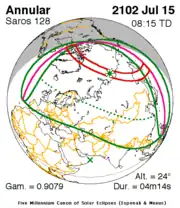 July 15, 2102 |
| 64 | 65 | 66 |
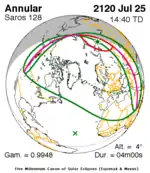 July 25, 2120 |
August 5, 2138 (Partial) | August 16, 2156 (Partial) |
| 67 | 68 | |
| August 27, 2174 (Partial) | September 6, 2192 (Partial) | |
Metonic series
The metonic series repeats eclipses every 19 years (6939.69 days), lasting about 5 cycles. Eclipses occur in nearly the same calendar date. In addition, the octon subseries repeats 1/5 of that or every 3.8 years (1387.94 days). All eclipses in this table occur at the Moon's descending node.
| 21 eclipse events between June 1, 2011 and June 1, 2087 | ||||
|---|---|---|---|---|
| May 31 – June 1 | March 19–20 | January 5–6 | October 24–25 | August 12–13 |
| 118 | 120 | 122 | 124 | 126 |
 June 1, 2011 |
 March 20, 2015 |
 January 6, 2019 |
 October 25, 2022 |
 August 12, 2026 |
| 128 | 130 | 132 | 134 | 136 |
 June 1, 2030 |
 March 20, 2034 |
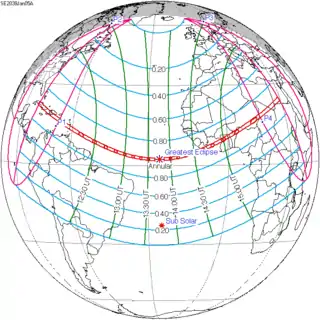 January 5, 2038 |
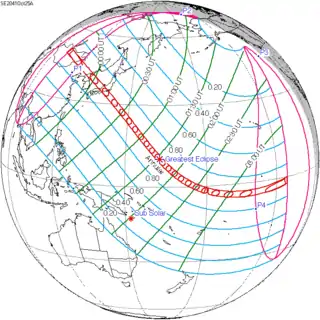 October 25, 2041 |
 August 12, 2045 |
| 138 | 140 | 142 | 144 | 146 |
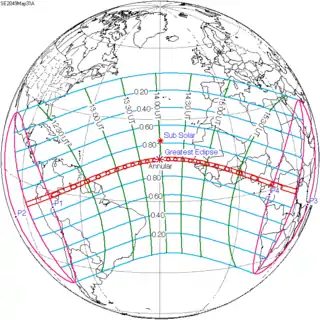 May 31, 2049 |
 March 20, 2053 |
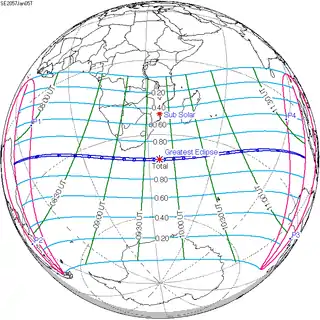 January 5, 2057 |
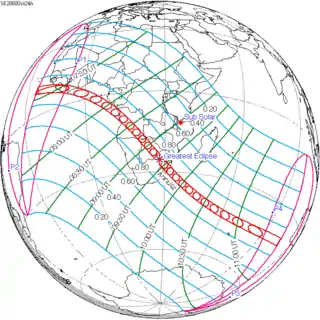 October 24, 2060 |
 August 12, 2064 |
| 148 | 150 | 152 | 154 | 156 |
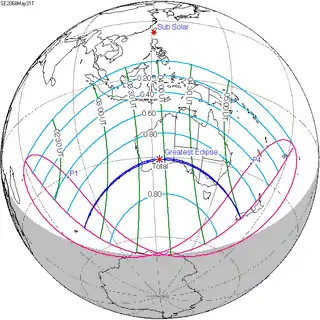 May 31, 2068 |
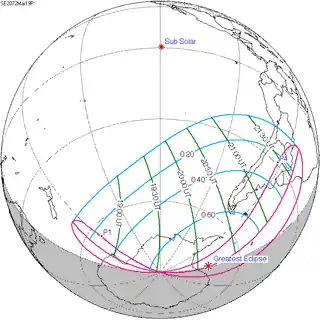 March 19, 2072 |
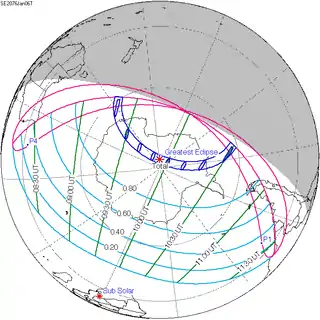 January 6, 2076 |
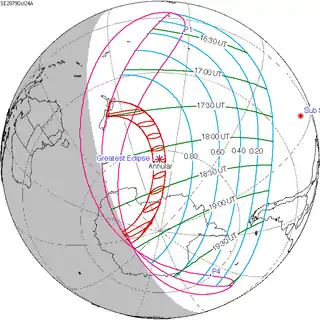 October 24, 2079 |
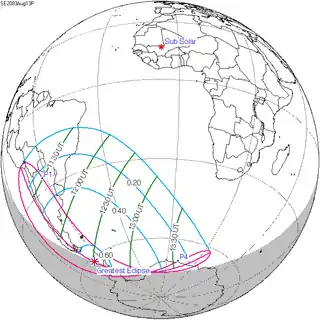 August 13, 2083 |
| 158 | 160 | 162 | 164 | 166 |
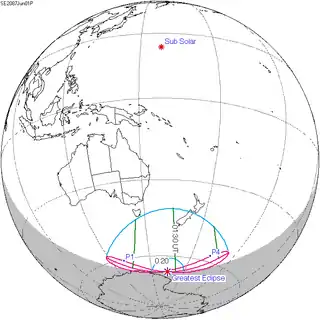 June 1, 2087 |
 October 24, 2098 |
|||
References
- ↑ van Gent, R.H. "Solar- and Lunar-Eclipse Predictions from Antiquity to the Present". A Catalogue of Eclipse Cycles. Utrecht University. Retrieved 6 October 2018.
External links
.jpg.webp)

